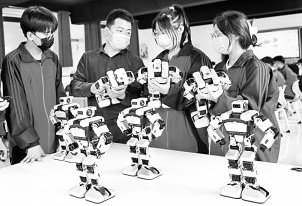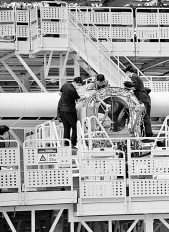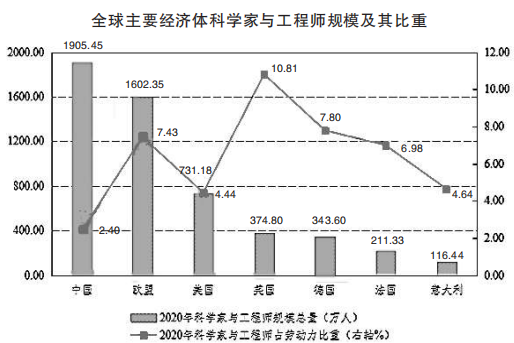To Build a Powerful Country and Cultivate More "Excellent Engineers" —— A Research Report on the Present Situation of Engineers in China
Author: Qin Fang (Associate Research Fellow, China Family Finance Research Center, Southwestern University of Finance and Economics); Xie Kai (PhD candidate, Institute of Economics and Management, Southwestern University of Finance and Economics); Gan Li (Director and Professor, China Family Finance Research and Research Center, Southwestern University of Finance and Economics)
editorial comment/note
Report to the 20th CPC National Congress of the Communist Party of China pointed out that "to speed up the construction of the national strategic talent force, and strive to cultivate more masters, strategic scientists, first-class scientific and technological leaders and innovative teams, young scientific and technological talents, outstanding engineers, great country craftsmen and highly skilled talents", and "outstanding engineers" were placed in an important position of the national strategic talent force.
As the largest country in engineering education in the world, under the overall leadership of the Party, China’s engineering education has made historic achievements, trained many high-level engineering and technical talents, and provided solid intellectual support for China and even the global industrial progress. Facing the new round of scientific and technological revolution and industrial transformation, how to build a team of engineers who love the party and serve the country, are dedicated, have outstanding technical innovation ability and are good at solving complex engineering problems? This edition features relevant research reports and expert articles.
Engineers are an important human capital in the national economic and social development, and an important force in implementing the strategy of rejuvenating the country through science and education, strengthening the country through talents and innovation-driven development. In order to achieve high-quality development, the primary task of building a socialist modern country in an all-round way, it is necessary to analyze and judge the supply and demand of engineers. According to the investigation, we should focus on solving the outstanding problems such as insufficient supply of high-level talents in key fields and the disconnection between engineering education and engineering ability training, continue to deepen the integration of production and education, and vigorously innovate the training mode of engineers.

In Jingxing Vocational and Technical Education Center, Shijiazhuang City, Hebei Province, teachers guide students to learn robot-related knowledge. Xinhua news agency
Look at the current situation: the scale is considerable, but it is still difficult to match the needs of manufacturing powers.
■ The total number of engineers is large, but it accounts for a low proportion of the labor force.According to the calculation of China Family Finance Research and Research Center of Southwestern University of Finance and Economics, by 2020, there are about 19.05 million scientists and engineers in China, including 17.653 million engineers, ranking among the top in the world. However, from the perspective of the proportion of the labor force, there is still room for growth. The proportion of scientists and engineers in the total labor force in China is 2.4%, which is 2.04% and 5.03% lower than that in the United States and the European Union respectively. This restricts the upgrading and optimization of China’s industrial structure to a certain extent, and there is still great potential to be tapped.
■ The scale of engineers does not match the status of manufacturing industry.China’s manufacturing industry ranks first in the world, and its added value accounts for a high proportion of GDP, but manufacturing engineers account for a low proportion of employees. In 2020, the proportion of scientists and engineers in China’s manufacturing industry is only 3.55%, far below the level of Germany’s 23.2% and the European Union’s 14.2%.

Liu Fei (third from left), the chief engineer of the National Convention and Exhibition Center (Tianjin), and the technical management staff check the drawings. Xinhua news agency
■The number of newly-added science and engineering graduates is considerable, but it accounts for a low proportion of the school-age population.Science and engineering graduates with higher education are the most important source of supply for engineers. In 2020, there will be about 3,423,100 new science and engineering graduates in China, far exceeding other economies, reflecting the scale advantage of China’s potential engineers. However, judging from the proportion of the school-age population (25-34 years old), China is only 1.58%, which is lower than that of France (2.74%) and South Korea (2.68%). The shortage of potential supply sources of engineers has become an important factor restricting the adjustment and upgrading of China’s industrial structure.
Look at the trend: the gap between supply and demand may further increase.
■ The engineer labor market has been in short supply for a long time.The recruitment ratio is the ratio of effective demand to effective job seekers in the labor market in a statistical period. Engineers in China have been in short supply for a long time, especially the demand for senior engineers far exceeds the number of job seekers. In recent years, driven by the epidemic situation in COVID-19 and the demand for upgrading industrial structure, the demand for junior, intermediate and senior engineers is in short supply, and the recruitment rate of junior engineers has increased greatly.
■ The gap between supply and demand of engineers will further increase in the future.According to the calculation of China Family Finance Research and Research Center of Southwestern University of Finance and Economics, according to the goal that the added value of China’s manufacturing industry accounts for a stable proportion of GDP, the gap between supply and demand of engineers in China will be expanded from less than 1% to 32% in the next 15 years. If the proportion of engineers in China’s labor force reaches the current average level of developed countries in 2035, the demand for engineers will be about 45 million. Data analysis shows that in 2023 — In 2035, the supply scale of engineers in China will increase from 20.592 million in 2023 to 31.911 million in 2035, and the gap between total demand and total supply will continue to widen.

Engineers carry out assembly work on the AG600M assembly line of Guangdong Zhuhai avic tongfei south China aircraft industry co., ltd.
Probe into the reason: the willingness to study in science and engineering and the willingness to work have both declined.
■ Young people’s willingness to study science and engineering majors has declined.The proportion of science and engineering graduates in the total graduates can reflect the willingness to study in related majors to some extent. With the expansion of colleges and universities in recent years, the scale of science and engineering graduates in China has increased steadily, however, the proportion in the total number of graduates has declined. In 2000, the proportion of science and engineering graduates in the total number of graduates in China was as high as 67%, and it will drop to less than 40% by 2020.
The decline of young people’s willingness to study science and engineering is a common problem faced by countries all over the world. The reasons are as follows: First, the learning difficulty of science and engineering-related majors is much higher than that of humanities and social sciences majors. The data shows that in 2017, only 48.0% of high school graduates in the United States were interested in science, technology, engineering and mathematics (hereinafter referred to as "STEM"), and less than 40% of college students who chose STEM when they entered school got professional degrees. Secondly, the teaching methods of science and engineering lack interest orientation. In China, the interest of primary and middle school students in learning STEM courses has obviously weakened with their age. Some schools and parents pay insufficient attention to cultivating students’ ability to discover, explore and solve problems, and generally ignore stimulating their interest in learning. In addition, factors such as poor employment prospects and high employment requirements have also led to a further decline in the willingness to apply for science and engineering majors.
■ The willingness of science and engineering college graduates to engage in engineering-related occupations has declined.The data show that only about 37% of science and engineering graduates in China are engaged in engineering-related occupations every year, and there is a downward trend. From the perspective of salary, although the average salary of graduates majoring in science and engineering is higher, the proportion of those with the highest salary income is lower than that of liberal arts majors. This shows that the study cost of science and engineering majors is high and the employment income is relatively low. In addition, a large number of science and engineering graduates choose to work in high-income monopoly industries, which intensifies the mismatch of human capital and leads to the shortage of "reserve army" for engineers.
Seeking countermeasures: improving employment will and taking the road of self-cultivation of talents
■ Improve the top-level design and drive the supply of engineers with industrial policies.We should focus on strategic emerging industries, such as information technology, biotechnology, new energy, new materials, high-end equipment, etc., and increase support for the training of urgently needed and scarce engineering and technical personnel; Promote the transformation and upgrading of manufacturing industry and attract more talents with the prospect of industrial demand. We will improve the training system for high-skilled talents, focus on the demand for high-skilled talents from major national strategies, major projects, major projects and key industries, implement the training plan for high-skilled leading talents, and enhance the country’s core competitiveness and scientific and technological innovation capability.
■ Stimulate students’ interest in the study and research of basic disciplines such as science, technology, engineering and mathematics.We should give consideration to the needs of economic and social development and learners’ personal growth willingness, and provide more support and incentives for students who are willing to study STEM courses. Start the pre-school children’s scientific literacy training program, incorporate the mathematics and scientific enlightenment system into children’s daily education, help children build basic experience in natural science, mathematics and technology, and lay an interest and cognitive foundation for systematically learning STEM professional knowledge after entering school. By organizing national science and engineering competitions and setting up STEM scholarship programs, young students’ interest in science, technology, engineering and mathematics will be improved.

(Source: World Bank, National Science Foundation, Eurostat, China Household Finance Survey Database. EU data does not include the UK)
■ Improve the quality of engineering and technical personnel training in colleges and universities, and promote employment willingness.Cultivating high-quality engineers who meet the needs of society is the main way to narrow the gap between the expected income and the actual income of science and engineering students and enhance their employment willingness. Through education and close cooperation with industries, universities and enterprises, various types of outstanding engineers are trained. On the one hand, fully mobilize the enthusiasm of schools and enterprises, jointly design training objectives, formulate training plans and implement training plans, and realize the deep integration of engineering and technical personnel training and engineering practice; On the other hand, we will continue to implement and improve a new round of talent training policies for science and engineering students in higher education, such as the "Everest Plan" and the construction of new engineering courses, and learn from the relevant experience of other countries to create a training model for engineering talents with China characteristics.
■ Further expand the career development space of engineering and technical personnel, and continuously create a social atmosphere that respects engineering and technical personnel.Enhance the willingness of science and engineering graduates to engage in engineering occupations by practical means, such as increasing the income of engineering posts and eliminating the differences in treatment and welfare of highly educated engineering and technical personnel participating in different series of titles; Improve the relevant laws and stipulate the assessment and registration that engineers need to accept; Give full play to the role of engineering associations, science and technology associations, trade associations and other institutions, improve the ability standards of outstanding engineers with China characteristics, promote their organic connection with professional qualification certification, and establish an outstanding engineer certification system that is in line with international standards and complements each other.